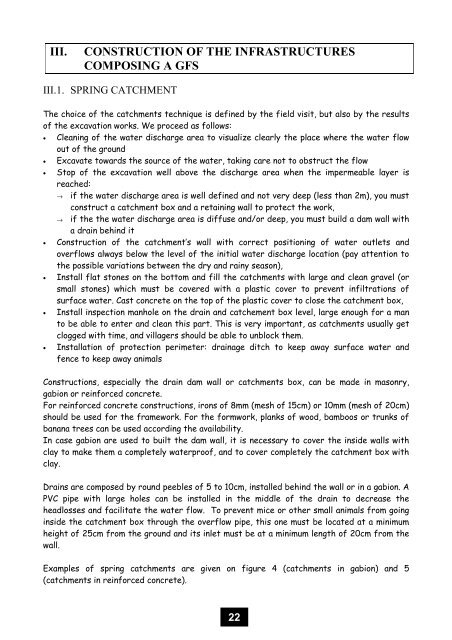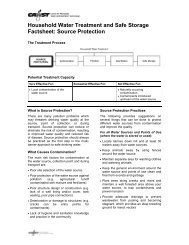Module 4 - Construction of a gravity fed system
Module 4 - Construction of a gravity fed system
Module 4 - Construction of a gravity fed system
You also want an ePaper? Increase the reach of your titles
YUMPU automatically turns print PDFs into web optimized ePapers that Google loves.
III.<br />
CONSTRUCTION OF THE INFRASTRUCTURES<br />
COMPOSING A GFS<br />
III.1. SPRING CATCHMENT<br />
The choice <strong>of</strong> the catchments technique is defined by the field visit, but also by the results<br />
<strong>of</strong> the excavation works. We proceed as follows:<br />
• Cleaning <strong>of</strong> the water discharge area to visualize clearly the place where the water flow<br />
out <strong>of</strong> the ground<br />
• Excavate towards the source <strong>of</strong> the water, taking care not to obstruct the flow<br />
• Stop <strong>of</strong> the excavation well above the discharge area when the impermeable layer is<br />
reached:<br />
→ if the water discharge area is well defined and not very deep (less than 2m), you must<br />
construct a catchment box and a retaining wall to protect the work,<br />
→ if the the water discharge area is diffuse and/or deep, you must build a dam wall with<br />
a drain behind it<br />
• <strong>Construction</strong> <strong>of</strong> the catchment’s wall with correct positioning <strong>of</strong> water outlets and<br />
overflows always below the level <strong>of</strong> the initial water discharge location (pay attention to<br />
the possible variations between the dry and rainy season),<br />
• Install flat stones on the bottom and fill the catchments with large and clean gravel (or<br />
small stones) which must be covered with a plastic cover to prevent infiltrations <strong>of</strong><br />
surface water. Cast concrete on the top <strong>of</strong> the plastic cover to close the catchment box,<br />
• Install inspection manhole on the drain and catchement box level, large enough for a man<br />
to be able to enter and clean this part. This is very important, as catchments usually get<br />
clogged with time, and villagers should be able to unblock them.<br />
• Installation <strong>of</strong> protection perimeter: drainage ditch to keep away surface water and<br />
fence to keep away animals<br />
<strong>Construction</strong>s, especially the drain dam wall or catchments box, can be made in masonry,<br />
gabion or reinforced concrete.<br />
For reinforced concrete constructions, irons <strong>of</strong> 8mm (mesh <strong>of</strong> 15cm) or 10mm (mesh <strong>of</strong> 20cm)<br />
should be used for the framework. For the formwork, planks <strong>of</strong> wood, bamboos or trunks <strong>of</strong><br />
banana trees can be used according the availability.<br />
In case gabion are used to built the dam wall, it is necessary to cover the inside walls with<br />
clay to make them a completely waterpro<strong>of</strong>, and to cover completely the catchment box with<br />
clay.<br />
Drains are composed by round peebles <strong>of</strong> 5 to 10cm, installed behind the wall or in a gabion. A<br />
PVC pipe with large holes can be installed in the middle <strong>of</strong> the drain to decrease the<br />
headlosses and facilitate the water flow. To prevent mice or other small animals from going<br />
inside the catchment box through the overflow pipe, this one must be located at a minimum<br />
height <strong>of</strong> 25cm from the ground and its inlet must be at a minimum length <strong>of</strong> 20cm from the<br />
wall.<br />
Examples <strong>of</strong> spring catchments are given on figure 4 (catchments in gabion) and 5<br />
(catchments in reinforced concrete).<br />
22

















